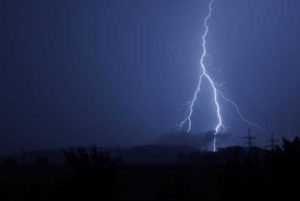
Lightning strikes in the Arctic tripled from 2010 to 2020, a finding University of Washington researchers attribute to rising temperatures due to human-caused climate change. The results, researchers say, suggest Arctic residents in northern Russia, Canada, Europe and Alaska need to prepare for the danger of more frequent lightning strikes.
The study, published March 22 in Geophysical Research Letters, used data from the UW-based World Wide Lightning Location Network to map lightning strikes across the globe from 2010 to 2020. WWLLN sensors detect the short burst of radio waves emitted during a lightning strike.
The new study found the number of lightning strikes above 65 degrees north latitude during the summer months tripled from 2010 to 2020 as compared to the total number of lightning strikes over the entire globe during the same period.
“With long periods of ice-free ocean and increasing shipping in the Arctic, you’re going to have the same problem you have at lower latitudes — when there’s a lot of people and they don’t know about the lightning threat and it becomes a problem,” said lead author Robert Holzworth, a UW professor emeritus of Earth and space sciences.
Holzworth and his colleagues analyzed the frequency of Arctic lightning strikes occurring during the summer months of June, July and August from 2010 to 2020. They found the percentage of lightning strikes occurring in the Arctic tripled from 0.2% of global lightning strikes in 2010 to 0.6% in 2020. The actual number of lightning strikes above 65 degrees north increased from about 18,000 in 2010 to over 150,000 in 2020.
During the same time period, Arctic temperatures increased from 0.65 to 0.95 degrees Celsius above pre-industrial times. Holzworth and his colleagues attribute the increased lightning strikes to these rising temperatures, as warmer summers mean more chances for intense thunderstorms to develop and create lightning.
Lightning in the Arctic is historically rare, as it usually isn’t warm enough to generate the right thunderstorm conditions during which lightning occurs. But researchers have recently noticed more strikes occurring in the northernmost latitudes and they even reported several lightning strikes near the north pole in August 2019. Lightning strikes that do occur in the Arctic tend to happen in the summer when thunderstorms are most likely to form.
The Arctic is warming faster than any other region on Earth, and the study authors found the uptick in lightning strikes matched rising temperatures in the region over the past decade. Arctic temperatures increased by 0.3 degrees Celsius from 2010 to 2020; that warming has created more favorable conditions for intense summer thunderstorms that produce lightning, according to the authors.
Arctic sea ice is declining by about 13% every decade, according to NASA. Less ice means more ocean will be available for shipping through the Arctic, especially in the summer months. Countries like Russia, China, Canada and the United States are already preparing to use the Arctic Ocean as a viable shipping route in the future.
The new study suggests shipping vessels throughout the Arctic could be more vulnerable to lightning strikes, in addition to those who call the Arctic home.
Co-authors are Michael McCarthy, Abram Jacobson, Craig Rodger and Todd Anderson at the UW; and James Brundell at the University of Otago in New Zealand.
Source: University of Washington








